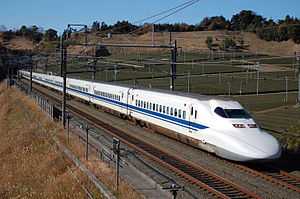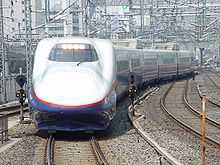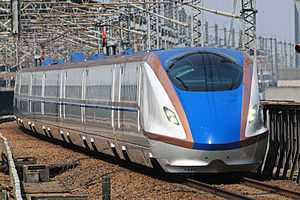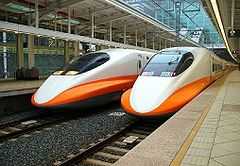Hokkaido Shinkansen
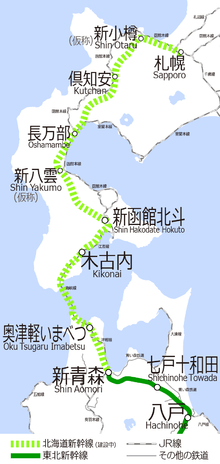
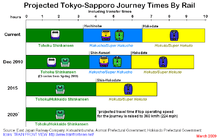
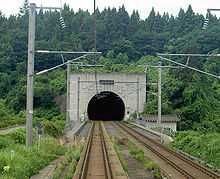
The Hokkaido Shinkansen (北海道新幹線 Hokkaidō Shinkansen) is a Japanese high-speed shinkansen rail line constructed between Aomori Prefecture in Honshu and Hokkaido through the undersea Seikan Tunnel. Construction started in May 2005, and the initial Shin-Aomori to Shin-Hakodate-Hokuto section is projected to open in March 2016. On 30 June 2012, the government approved construction of the line to Sapporo by fiscal 2035.[1][2] The line will be operated by the Hokkaido Railway Company (JR Hokkaido).[3]
Outline
In preparation for the opening of the Hokkaido Shinkansen, the Seikan Tunnel (Kaikyō Line) is being converted to dual gauge, with both the Shinkansen's 1,435 mm (4 ft 8 1⁄2 in) standard and 1,067 mm (3 ft 6 in) narrow-gauge tracks.
The Tohoku Shinkansen to Shin-Aomori operates at a maximum speed of 320 km/h (200 mph). JR East has announced that it is investigating the feasibility of increasing the maximum speed to 360 km/h (225 mph) by 2020.
Operations
Two train service types will operate on the Hokkaido Shinkansen: Hayabusa services between Tokyo or Sendai and Shin-Hakodate-Hokuto, and Hayate services between Morioka or Shin-Aomori and Shin-Hakodate-Hokuto.[4]
Initially the maximum speed through the Seikan Tunnel will be 140 km/h (85 mph) due to the risk of a narrow gauge freight train travelling in the opposite direction being derailed by the shockwave of air that moves ahead of Shinkansen trains at higher speeds in tunnels. There are approximately 50 freight trains passing through the Seikan Tunnel each day, so limiting the travel of such trains through the tunnel to times outside of Shinkansen services is not an option.
By 2018, it is proposed to allow one Shinkansen service each day to travel at 260 km/h (160 mph) (the maximum speed proposed for the tunnel) by ensuring no freight trains are scheduled to travel through the tunnel at that time. To achieve the full benefit of Shinkansen trains travelling through the tunnel at 260 km/h (160 mph), other alternatives are being considered, such as a system to automatically slow Shinkansen trains down to 200 km/h (125 mph) when passing narrow gauge trains, and loading freight trains onto special "Train on Train" standard gauge trains (akin to a covered piggyback flatcar train) built to withstand the shockwaves of oncoming Shinkansen trains traveling at full speed. This would enable a travel time from Tokyo to Shin-Hakodate-Hokuto of 3 hours and 45 minutes.
Stations
| Station name | Japanese | Distance (km) | Transfers | Location | |
|---|---|---|---|---|---|
| Scheduled to open March 2016 | |||||
| Shin-Aomori | 新青森 | 0.0 | Ōu Main Line, Tohoku Shinkansen | Aomori | Aomori |
| Oku-Tsugaru-Imabetsu | 奥津軽いまべつ | 38.5 | Tsugaru Line (Tsugaru-Futamata) Tsugaru-Kaikyō Line (Tsugaru-Imabetsu[* 1]) | Imabetsu | |
| Seikan Tunnel | |||||
| Kikonai | 木古内 | 113.3 | Esashi Line, Kaikyō Line | Kikonai | Hokkaido |
| Shin-Hakodate-Hokuto | 新函館北斗 | 148.9 | Hakodate Main Line (Oshima-Ōno[* 1]) | Hokuto | |
| Under construction. Scheduled to open 2035 | |||||
| Shin-Yakumo[* 2] | 新八雲 | 203.0 | Yakumo | Hokkaido | |
| Oshamambe | 長万部 | 236.1 | Hakodate Main Line, Muroran Main Line | Oshamambe | |
| Kutchan | 倶知安 | 290.2 | Hakodate Main Line | Kutchan | |
| Shin-Otaru[* 2] | 新小樽 | 328.2 | Otaru | ||
| Sapporo | 札幌 | 360.2 | Chitose Line, Hakodate Main Line, Sasshō Line (Gakuen-Toshi Line) Namboku Line, Tōhō Line | Kita-ku, Sapporo | |
Rolling stock
In February 2014, JR Hokkaido placed an order for four 10-car H5 Series Shinkansen trainsets for use on Hokkaido Shinkansen services from March 2016.[5] Based on the E5 series trainsets operated by JR East since 2011, the order for 40 vehicles cost approximately 18 billion yen.[5] The first two sets of the order are scheduled to be delivered to Hakodate Depot by road from Hakodate Port in October 2014, with test running commencing before the end of the year.[6] The remaining two sets on order are scheduled to be delivered in 2015.[6]
History
In the early 1970s, two other Shinkansen routes were proposed for Hokkaido: Sapporo - Asahikawa (Hokkaido Shinkansen extension) and Oshamambe - Muroran – Sapporo (Hokkaido South Route). There were also further unofficial plans to connect to Abashiri, Kushiro, and Wakkanai. These plans have been indefinitely shelved.
On 1 November 2014, a ceremony was held at Kikonai Station to mark the completion of track-laying for the line between Shin-Aomori and Shin-Hakodate-Hokuto.[7]
Test-running on the Hokkaido Shinkansen tracks within Hokkaido commenced from 1 December 2014, initially at low speeds, with the speed due to be raised to the maximum of 260 km/h later during the month.[8] Test-running is scheduled to be extended through the Seikan Tunnel to Oku-Tsugaru-Imabetsu by March 2015, and to Shin-Aomori later during fiscal 2015.[8]
Future plans
JR Hokkaido is extending the Hokkaido Shinkansen from Shin-Hakodate to Sapporo, planned to open by 2035. Tunnelling work on the 5,265 m (17,274 ft) Murayama tunnel, situated about 18 kilometres (11 mi) north of Shin-Hakodate station is proposed to commence by March 2015, and be completed by March 2021. If Hokkaido Shinkansen services are ultimately able to be operated at speeds of up to 360 km/h (225 mph), the estimated journey time from Tokyo to Sapporo would be 5 hours and 1 minute.[1]
With the opening of the Hokkaido Shinkansen in March 2016, the section of the conventional (narrow gauge) Esashi Line running along approximately the same route between Goryōkaku and Kikonai is due to be transferred from the control of JR Hokkaido to a newly established third-sector railway operating company, South Hokkaido Railway Company, becoming the Isaribi Line.[9]
References
| Wikimedia Commons has media related to Hokkaido Shinkansen. |
- ↑ 1.0 1.1 Press, Jiji. "Shinkansen to get 3 new sections". Daily Yomiuri Online. The Yomiuri Shimbun. Archived from the original on 7 July 2012. Retrieved 22 September 2014.
- ↑ "Bullet-train extensions approved". The Japan Times (Japan: The Japan Times Ltd.). 30 June 2012. p. 2.
- ↑ "DPJ may OK three new bullet-train sections". The Japan Times. Japan: The Japan Times Ltd. 17 December 2011. p. 1. Retrieved 22 September 2014.
- ↑ 北海道新幹線の列車名決定について [Details of Hokkaido Shinkansen train names] (PDF). News release (in Japanese). Japan: Hokkaido Railway Company. 20 November 2014. Retrieved 20 November 2014.
- ↑ 5.0 5.1 北海道新幹線「H5系」、内装には雪の結晶も [Hokkaido Shinkansen "H5 series" - Interiors to feature snowflake design]. Yomiuri Online (in Japanese). Japan: The Yomiuri Shimbun. 16 April 2014. Retrieved 16 April 2014.
- ↑ 6.0 6.1 北海道新幹線車両、函館港に10月陸揚げ 今年まず20両、基地へ陸送 [Hokkaido Shinkansen trains to arrive at Hakodate Port in October with 20 vehicles delivered to depot this year]. Doshin Web (in Japanese). Japan: The Hokkaido Shimbun Press. 19 March 2014. Retrieved 19 March 2014.
- ↑ 北海道新幹線(新青森・新函館北斗間)レール締結式の開催について [Hokkaido Shinkansen rail joining ceremony] (PDF). Press release (in Japanese). Japan: Japan Railway Construction, Transport and Technology Agency. 19 September 2014. Retrieved 22 September 2014.
- ↑ 8.0 8.1 Suzuki, Katsuichi (1 December 2014). 北海道新幹線:試験走行始まる 下旬には260キロで [Hokkaido Shinkansen test running starts - 260 km/h by early December]. Mainichi Shimbun (in Japanese). Japan: The Mainichi Newspapers. Retrieved 1 December 2014.
- ↑ 道南いさりび鉄道、ロゴマークを発表…津軽海峡をモチーフ [South Hokkaido Railway Company unveils logo - Tsugaru Straits motif]. Response (in Japanese). Japan: IID Inc. 23 March 2015. Retrieved 24 March 2015.
| |||||||||||||||||||||||||||||||||||||||||||||||||||||||||||||||||||||||||||||
